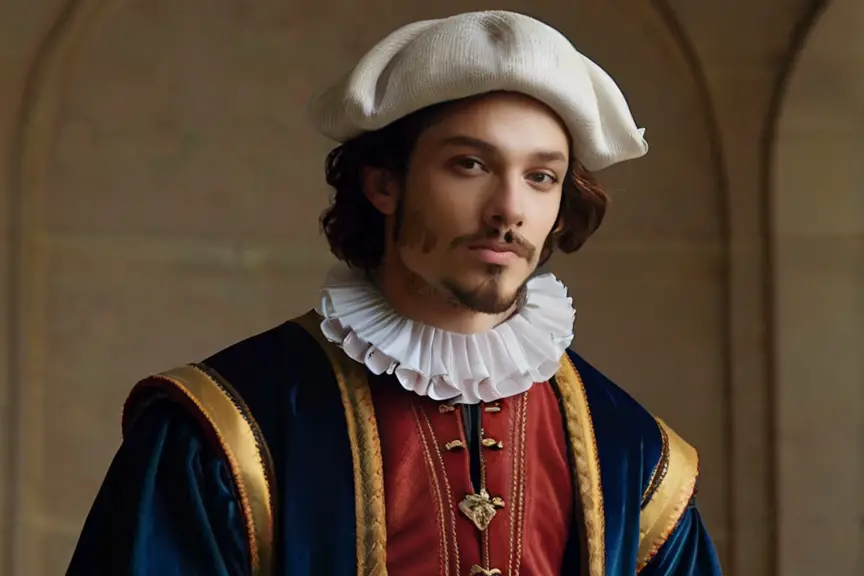
Renaissance fashion for men is a timeless style that has captivated the world with its elegance and sophistication.
This blog post will delve into the details of Renaissance male fashion, including undergarments, outerwear, accessories, and the social status associated with this fashion.
We will also explore the influence of Renaissance fashion on modern menswear and provide answers to frequently asked questions.
Renaissance Male Fashion Style
Renaissance fashion for men was characterized by a focus on elegance, comfort, and practicality.
Clothing was tailored to fit the body, with an emphasis on symmetry and balance.
This style was popular during the 14th to 17th centuries, with the peak of its popularity being the 16th century.
- Read also: Contrasting Worlds: Renaissance Art Vs. Medieval Art
- Read also: Exploring Famous Renaissance Architecture
Undergarments
Shirts
Renaissance shirts were primarily crafted from linen or wool.
Linen shirts were favored for their breathability, ideal for warmer weather, while wool shirts provided warmth during colder seasons.
These shirts were often tailored with precision to fit snugly against the body. To enhance comfort, many shirts featured a soft linen lining.
Breeches
The term “breeches” referred to short trousers worn by men during the Renaissance.
These were typically made from wool, a durable and versatile fabric of the time.
Breeches came in various styles, ranging from snug-fitting to slightly looser designs, depending on personal preference and social status.
They were secured around the waist with a belt or sash, ensuring a proper fit and ease of movement.
Stockings
Completing the ensemble were stockings, essential for covering the legs.
These were commonly made from wool or silk and were worn beneath the breeches.
Stockings not only provided warmth but also added a touch of elegance to the overall attire.
They were available in an array of colors and designs, allowing individuals to express their personal style.

Outerwear
Coats
Coats were a staple in Renaissance outerwear, providing both style and functionality.
Crafted from luxurious materials such as wool or velvet, these garments exuded opulence.
Coats were often tailored to fit the wearer’s frame, with attention to detail in the stitching and embellishments.
To ensure warmth, coats were lined with soft fabrics, offering comfort even during chilly weather.
Capes
For formal occasions or when making a grand entrance, capes were the go-to choice for Renaissance gentlemen.
These regal garments, typically made from velvet or silk, added an air of nobility to any ensemble.
Capes flowed gracefully over the shoulders, draping down the back in a majestic fashion.
They served not only as a fashion statement but also as a symbol of prestige and authority.
Mantles
A distinctive type of cloak known as mantles also found its place in Renaissance fashion.
Mantles were characterized by their unique design, draped over one shoulder and fastened at the neck.
Often crafted from luxurious materials like fur or velvet, mantles provided both warmth and elegance.
Whether worn for practicality or as a status symbol, mantles added a touch of drama to any outfit.
Accessories
Hats
Hats were not merely functional but also served as a stylish statement piece.
Crafted from felt or leather, Renaissance hats came in a variety of shapes and styles to suit different occasions and personal tastes.
Feathers, ribbons, and other ornate embellishments adorned these headpieces, adding flair and sophistication to the wearer’s ensemble.
Whether sporting a broad-brimmed hat or a more tailored cap, men used hats to express their individuality and elevate their look.
Gloves
A symbol of refinement and elegance, gloves were an essential accessory for Renaissance gentlemen.
Made from luxurious materials such as leather or silk, gloves were not only practical for protecting hands but also served as a status symbol.
The quality of the material and the intricacy of the design reflected the wearer’s social standing.
Wealthier individuals often flaunted finely crafted gloves adorned with delicate embroidery or embellishments, showcasing their affluent lifestyle.
Jewelry
In Renaissance fashion, jewelry was more than just decorative adornments; it was a manifestation of wealth and prestige.
Men adorned themselves with an array of jewels, including rings, necklaces, and earrings, to showcase their prosperity and social standing.
Precious metals such as gold and silver were intricately worked into intricate designs, while gemstones added a touch of color and opulence.
From simple signet rings to elaborate necklaces, jewelry was a testament to the wearer’s affluence and taste.

Social status and fashion
Wealth and elaboration
Fashion during the Renaissance was intricately intertwined with social status.
The wealthier a man was, the more elaborate and luxurious his clothing and accessories would be.
Rich fabrics like velvet and silk, intricate embroidery, and lavish embellishments were all indicative of high social standing.
These opulent garments served not only as a display of wealth but also as a means of asserting one’s prestige and influence within society.
Distinctive signifiers
Beyond the quality of materials and craftsmanship, certain garments and accessories were reserved exclusively for the elite.
Sumptuous fur-lined coats, intricately jeweled accessories, and elaborately embroidered garments were all exclusive symbols of nobility and aristocracy.
These distinctive signifiers of wealth and status helped reinforce social hierarchies and delineate the boundaries between different classes within Renaissance society.
Influence of Renaissance Fashion on Modern Menswear
The impact of Renaissance fashion on modern menswear is undeniable.
Contemporary designers continually look to this historical period for inspiration, integrating various elements into their collections.
From refined tailoring to the use of opulent fabrics and elaborate embellishments, Renaissance aesthetics have left an enduring mark on today’s fashion landscape.
Tailored silhouettes
One of the key influences of Renaissance fashion on modern menswear is the emphasis on tailored silhouettes.
During the Renaissance era, clothing was meticulously crafted to fit the body, enhancing the wearer’s stature and conveying a sense of refinement.
This attention to detail is echoed in contemporary menswear, where well-fitted garments remain a hallmark of sophisticated style.
Luxurious fabrics
Luxurious fabrics were a hallmark of Renaissance attire, with nobles and aristocrats adorning themselves in sumptuous materials such as velvet, silk, and brocade.
Today, modern menswear designers continue to incorporate these opulent textiles into their collections, infusing garments with a sense of luxury and elegance.
Intricate details
Intricate details were a defining feature of Renaissance fashion, with garments adorned with elaborate embroidery, intricate patterns, and ornate embellishments.
This commitment to craftsmanship and attention to detail has influenced modern menswear, with designers often incorporating decorative elements that add depth and visual interest to their creations.

- Read also: Famous Renaissance Poets Who Shaped Literature
- Read also: Renaissance Invention Timeline: Innovations That Transformed History
Conclusion
The enduring charm of Renaissance fashion for men serves as a timeless muse for contemporary menswear.
Delving into its core components, including undergarments, outerwear, and accessories, unveils the grace and refinement that defined this era’s style.
Understanding these elements allows us to fully appreciate the elegance and sophistication that characterized Renaissance fashion.


